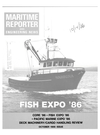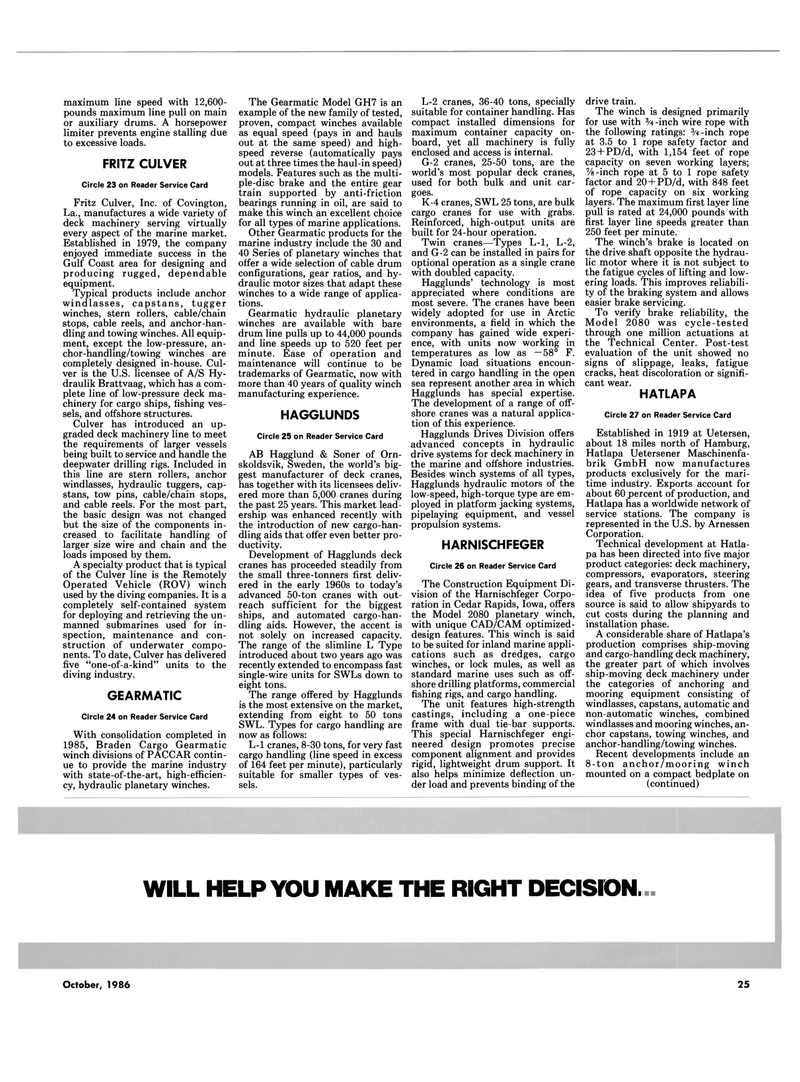
Page 23: of Maritime Reporter Magazine (October 1986)
Read this page in Pdf, Flash or Html5 edition of October 1986 Maritime Reporter Magazine
maximum line speed with 12,600- pounds maximum line pull on main or auxiliary drums. A horsepower limiter prevents engine stalling due to excessive loads.
FRITZ CULVER
Circle 23 on Reader Service Card
Fritz Culver, Inc. of Covington,
La., manufactures a wide variety of deck machinery serving virtually every aspect of the marine market.
Established in 1979, the company enjoyed immediate success in the
Gulf Coast area for designing and producing rugged, dependable equipment.
Typical products include anchor windlasses, capstans, tugger winches, stern rollers, cable/chain stops, cable reels, and anchor-han- dling and towing winches. All equip- ment, except the low-pressure, an- chor-handling/towing winches are completely designed in-house. Cul- ver is the U.S. licensee of A/S Hy- draulik Brattvaag, which has a com- plete line of low-pressure deck ma- chinery for cargo ships, fishing ves- sels, and offshore structures.
Culver has introduced an up- graded deck machinery line to meet the requirements of larger vessels being built to service and handle the deepwater drilling rigs. Included in this line are stern rollers, anchor windlasses, hydraulic tuggers, cap- stans, tow pins, cable/chain stops, and cable reels. For the most part, the basic design was not changed but the size of the components in- creased to facilitate handling of larger size wire and chain and the loads imposed by them.
A specialty product that is typical of the Culver line is the Remotely
Operated Vehicle (ROV) winch used by the diving companies. It is a completely self-contained system for deploying and retrieving the un- manned submarines used for in- spection, maintenance and con- struction of underwater compo- nents. To date, Culver has delivered five "one-of-a-kind" units to the diving industry.
GEARMATIC
Circle 24 on Reader Service Card
With consolidation completed in 1985, Braden Cargo Gearmatic winch divisions of PACCAR contin- ue to provide the marine industry with state-of-the-art, high-efficien- cy, hydraulic planetary winches.
The Gearmatic Model GH7 is an example of the new family of tested, proven, compact winches available as equal speed (pays in and hauls out at the same speed) and high- speed reverse (automatically pays out at three times the haul-in speed) models. Features such as the multi- ple-disc brake and the entire gear train supported by anti-friction bearings running in oil, are said to make this winch an excellent choice for all types of marine applications.
Other Gearmatic products for the marine industry include the 30 and 40 Series of planetary winches that offer a wide selection of cable drum configurations, gear ratios, and hy- draulic motor sizes that adapt these winches to a wide range of applica- tions.
Gearmatic hydraulic planetary winches are available with bare drum line pulls up to 44,000 pounds and line speeds up to 520 feet per minute. Ease of operation and maintenance will continue to be trademarks of Gearmatic, now with more than 40 years of quality winch manufacturing experience.
HAGGLUNDS
Circle 25 on Reader Service Card
AB Hagglund & Soner of Orn- skoldsvik, Sweden, the world's big- gest manufacturer of deck cranes, has together with its licensees deliv- ered more than 5,000 cranes during the past 25 years. This market lead- ership was enhanced recently with the introduction of new cargo-han- dling aids that offer even better pro- ductivity.
Development of Hagglunds deck cranes has proceeded steadily from the small three-tonners first deliv- ered in the early 1960s to today's advanced 50-ton cranes with out- reach sufficient for the biggest ships, and automated cargo-han- dling aids. However, the accent is not solely on increased capacity.
The range of the slimline L Type introduced about two years ago was recently extended to encompass fast single-wire units for SWLs down to eight tons.
The range offered by Hagglunds is the most extensive on the market, extending from eight to 50 tons
SWL. Types for cargo handling are now as follows:
L-l cranes, 8-30 tons, for very fast cargo handling (line speed in excess of 164 feet per minute), particularly suitable for smaller types of ves- sels.
L-2 cranes, 36-40 tons, specially suitable for container handling. Has compact installed dimensions for maximum container capacity on- board, yet all machinery is fully enclosed and access is internal.
G-2 cranes, 25-50 tons, are the world's most popular deck cranes, used for both bulk and unit car- goes.
K-4 cranes, SWL 25 tons, are bulk cargo cranes for use with grabs.
Reinforced, high-output units are built for 24-hour operation.
Twin cranes—Types L-l, L-2, and G-2 can be installed in pairs for optional operation as a single crane with doubled capacity.
Hagglunds' technology is most appreciated where conditions are most severe. The cranes have been widely adopted for use in Arctic environments, a field in which the company has gained wide experi- ence, with units now working in temperatures as low as —58° F.
Dynamic load situations encoun- tered in cargo handling in the open sea represent another area in which
Hagglunds has special expertise.
The development of a range of off- shore cranes was a natural applica- tion of this experience.
Hagglunds Drives Division offers advanced concepts in hydraulic drive systems for deck machinery in the marine and offshore industries.
Besides winch systems of all types,
Hagglunds hydraulic motors of the low-speed, high-torque type are em- ployed in platform jacking systems, pipelaying equipment, and vessel propulsion systems.
HARNISCHFEGER
Circle 26 on Reader Service Card
The Construction Equipment Di- vision of the Harnischfeger Corpo- ration in Cedar Rapids, Iowa, offers the Model 2080 planetary winch, with unique CAD/CAM optimized- design features. This winch is said to be suited for inland marine appli- cations such as dredges, cargo winches, or lock mules, as well as standard marine uses such as off- shore drilling platforms, commercial fishing rigs, and cargo handling.
The unit features high-strength castings, including a one-piece frame with dual tie-bar supports.
This special Harnischfeger engi- neered design promotes precise component alignment and provides rigid, lightweight drum support. It also helps minimize deflection un- der load and prevents binding of the drive train.
The winch is designed primarily for use with 3/4-inch wire rope with the following ratings: 3/4-inch rope at 3.5 to 1 rope safety factor and 23 + PD/d, with 1,154 feet of rope capacity on seven working layers; 7 /8-inch rope at 5 to 1 rope safety factor and 20 + PD/d, with 848 feet of rope capacity on six working layers. The maximum first layer line pull is rated at 24,000 pounds with first layer line speeds greater than 250 feet per minute.
The winch's brake is located on the drive shaft opposite the hydrau- lic motor where it is not subject to the fatigue cycles of lifting and low- ering loads. This improves reliabili- ty of the braking system and allows easier brake servicing.
To verify brake reliability, the
Model 2080 was cycle-tested through one million actuations at the Technical Center. Post-test evaluation of the unit showed no signs of slippage, leaks, fatigue cracks, heat discoloration or signifi- cant wear.
HATLAPA
Circle 27 on Reader Service Card
Established in 1919 at Uetersen, about 18 miles north of Hamburg,
Hatlapa Uetersener Maschinenfa- brik GmbH now manufactures products exclusively for the mari- time industry. Exports account for about 60 percent of production, and
Hatlapa has a worldwide network of service stations. The company is represented in the U.S. by Arnessen
Corporation.
Technical development at Hatla- pa has been directed into five major product categories: deck machinery, compressors, evaporators, steering gears, and transverse thrusters. The idea of five products from one source is said to allow shipyards to cut costs during the planning and installation phase.
A considerable share of Hatlapa's production comprises ship-moving and cargo-handling deck machinery, the greater part of which involves ship-moving deck machinery under the categories of anchoring and mooring equipment consisting of windlasses, capstans, automatic and non-automatic winches, combined windlasses and mooring winches, an- chor capstans, towing winches, and anchor-handling/towing winches.
Recent developments include an 8-ton anchor/mooring winch mounted on a compact bedplate on (continued)
WILL HELP YOU MAKE THE RIGHT DECISION.
October, 1986 25

 22
22

 24
24
